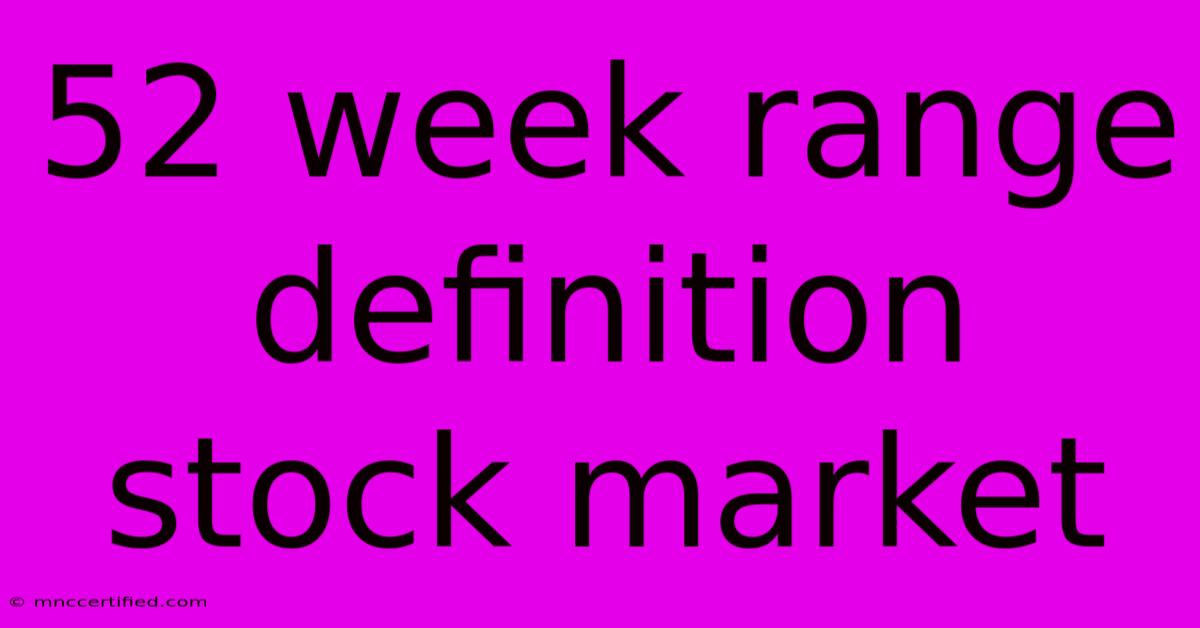52 Week Range Definition Stock Market

Table of Contents
Understanding the 52-Week Range: A Key Indicator for Stock Market Analysis
The stock market can be a complex and unpredictable landscape, but understanding key indicators can help investors navigate its waters more effectively. One such indicator is the 52-week range, a valuable tool for assessing the historical performance and potential future movement of a stock.
What is the 52-Week Range?
The 52-week range represents the highest and lowest prices a stock has traded at over the past year. It's presented as a simple range, typically in the format "Low - High". For instance, a stock with a 52-week range of "$10 - $20" indicates it traded at a low of $10 and a high of $20 within the last 52 weeks.
Why is the 52-Week Range Important?
The 52-week range provides valuable insights into a stock's:
- Price Volatility: A wide range suggests significant price fluctuations, potentially signaling a volatile stock. Conversely, a narrow range may indicate a stable stock with less price fluctuation.
- Support and Resistance Levels: The high and low ends of the range can act as potential support and resistance levels. Support levels represent areas where buyers are likely to step in and push prices higher, while resistance levels represent areas where sellers are likely to emerge and push prices lower.
- Historical Performance: The range offers a quick glimpse into the stock's recent performance, allowing investors to gauge whether it has been trending upwards, downwards, or staying relatively stable.
How to Use the 52-Week Range in Your Analysis
1. Identify Trends: A stock trading near its 52-week high may indicate an upward trend, while a stock trading near its 52-week low suggests a downward trend.
2. Spot Potential Breakouts: A stock breaking out above its 52-week high can be a bullish signal, indicating strong buying pressure and the potential for further price increases. Conversely, a break below the 52-week low can be a bearish signal, suggesting strong selling pressure and potential further price declines.
3. Gauge Relative Value: Comparing a stock's current price to its 52-week range can help determine if it's currently trading at a discount or premium. A stock trading near the lower end of its range may be undervalued, while a stock trading near the higher end may be overvalued.
4. Combine with Other Indicators: The 52-week range should not be used in isolation. It's best to combine it with other technical indicators, such as moving averages, relative strength index (RSI), and volume, for a more comprehensive picture.
Example:
Let's consider a hypothetical stock, XYZ, with a 52-week range of "$50 - $75".
- If XYZ is currently trading at $60, it's near the middle of its range, indicating potential for both upward and downward movement.
- If XYZ breaks above $75, it would signal a bullish breakout, indicating strong buying pressure and potentially further price increases.
- If XYZ falls below $50, it would signal a bearish breakout, indicating strong selling pressure and potentially further price declines.
Limitations of the 52-Week Range
While a useful tool, the 52-week range has limitations:
- Past Performance is not a Guarantee: The range reflects past performance, which may not necessarily predict future behavior.
- Market Conditions: The range can be influenced by overall market conditions, such as economic downturns or bull markets.
- Company-Specific Factors: The range doesn't account for company-specific factors, like new product launches or financial news, that can significantly impact stock prices.
Conclusion
The 52-week range is a valuable tool for understanding a stock's historical performance and potential future movement. By incorporating it into your analysis, you can identify trends, potential breakouts, and gauge relative value. However, it's important to remember that it's just one indicator, and it should be used in conjunction with other tools for a more comprehensive understanding of the market. Always conduct thorough research and consult with a financial advisor before making any investment decisions.

Thank you for visiting our website wich cover about 52 Week Range Definition Stock Market. We hope the information provided has been useful to you. Feel free to contact us if you have any questions or need further assistance. See you next time and dont miss to bookmark.
Featured Posts
-
West Ham Held By Everton In Goalless Draw
Nov 10, 2024
-
Progressive Insurance Fort Collins Co
Nov 10, 2024
-
Wrexhams Mc Clean Stands Firm On Poppy
Nov 10, 2024
-
The American Worker Insurance Doctors
Nov 10, 2024
-
Charlotte Tilbury Beauty Authoritys Claim
Nov 10, 2024